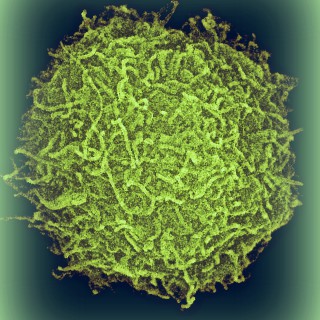Protein patterns – detectors of disease
In ten years, a blood test may be all that is needed for your doctor to see if you have cancer and decide what treatment is best for you personally. The specific combination of proteins in the blood reveals whether or not you are ill.
Analysing the composition of proteins using mass spectrometry could be the future of medical diagnosis. Within the research field of proteomics, researchers study the link between proteins and disease.
Knowledge of genes insufficient
Until ten years ago, it was hoped that the mapping of the human genome – all our genes – would enable us to better understand the course of different diseases. Today, researchers know that more detailed information is needed. We need to know more about the proteins that our genes produce. However, mapping all our proteins, which is the initial goal of the new research field known as proteomics, will take a long time.
“A lot happens in a cell when information is transferred from the genes’ coding to a protein”, explains Ákos Végvári, a researcher at the Division of Electrical Measurements at Lund University. The same protein can exist in different forms and different concentrations in different cells. We have around 20 000 genes that can produce at least 500 000 proteins.
Researchers are therefore now working on ‘disease-based proteomics’ as well. This means taking different types of cancer, for example, as the starting point and trying to identify the genes and the different protein variants that differ between healthy and ill individuals. The aim is to find diagnostic biomarkers that will make it possible to detect diseases early and to quickly tailor treatment.
Entire protein network has to be studied
Simple biomarkers have long been used in health care, says Johan Malm, Professor of Clinical Chemistry at Lund University and consultant at Labmedicin Skåne. A blood sample with low levels of haemoglobin and iron, for instance, can show that the patient is anaemic.
“But we want to find biomarkers that say ‘it is this specific disease, and not disease A or disease B’, and that is not possible for the most part at present”, says Johan Malm.
A few years ago, researchers believed that they would easily be able to identify individual biomarkers for different diseases, i.e. that one protein would be enough to diagnose a certain disease.
“However, that view has already changed – we can’t always quantify just one protein. There is often a whole network of proteins involved and that also changes in the different stages of the disease”, says Ákos Végvári. “We are now trying to look at the whole proteome, i.e. all the proteins in a certain type of cell at a certain time.”
Rare protein sequences found with mass spectrometry
One challenge is to develop the method of measurement with which small quantities of proteins can be found quickly and accurately, for example from a blood sample. Current methods, which are based on immunochemical methodology, for example to identify prostate cancer, are often not very sensitive and can only be used to point out a previously known biomarker. The researchers are now using mass spectrometry instead, a method that has long been used routinely around the world to measure levels of drugs or steroid hormones. The small molecules are identified by measuring their mass with a ‘mass analysis unit’.
“We want to find biomarkers that say ‘it is this specific disease’.”
In principle, this method can be used to analyse thousands of proteins at a time. However, a blood sample comprises a mixture of both small, simple molecules and more complicated ones. Certain molecules are always present at very high levels, while other, pathogenic proteins may only be present at very low levels and thus be difficult to detect.
The researchers are now nearing a way to target the measurements to these small concentrations. Proteins are formed of only 20 different amino acids, but almost all proteins are composed in such a way that part of the sequence is unique. It is this unique sequence that researchers use to identify and quantify the protein. By using three consecutive mass analysis units in mass spectrometry, the researchers can now filter out rare protein sequences.
Hope for routine use within ten years
There is a lot of work still to be done before the method can be routinely used to diagnose diseases.
“When we start using a new method of measurement, we have to be very careful so that we don’t measure incorrectly. We mustn’t measure anything other than the protein sequences that interest us”, says Ákos Végvári.
Therefore, it will take at least a year before they will be ready to start the research in earnest by looking for new biomarkers in hundreds of biological samples. One challenge is to find things that are of practical use among the large quantity of information produced by the analyses.
“We will compare people who have a certain disease with healthy individuals and see if there is any difference in the patterns of proteins they have”, explains Jonas Malm. “Do those who are ill have more or less of a particular protein or proteins or do they have a molecule that isn’t found at all in the healthy individuals?”
Johan Malm and Ákos Végvári hope that routine analysis of a number of biomarkers and protein patterns could be carried out in our hospitals within ten years. With greater knowledge of the link between proteins and diseases, and with greater precision in the analyses, the aim is to be able to quickly tailor treatment to the individual patient.
Text: Pia Romare
Publicerad: 2014
Facts
-
Genes
-
Our genes contain all the coded information necessary for us to function. A gene is a special section of the two long, identical chains of DNA known as chromosomes that determine our hereditary character. In total, humans have 23 pairs of chromosomes which together contain some 20 300 genes. The human genome was mapped as part of the HUGO project (Human Genome Organization). Genes provide information on the structure of proteins. Sometimes, mutations (permanent changes) take place in the genetic material or when the information is being transferred with the help of RNA.
-
Proteins
-
Proteins form the building blocks of the body and control vital processes. Unlike DNA molecules, which are branchless structures formed of only four basic components, proteins are complicated structures comprising multiple, sometimes branched, chains. Proteins are formed from 20 different amino acids, which can be compiled into a countless number of variants. Mutations affect the structure and function of a protein.
-
Cell functions
-
The function of cells is linked to proteins and not to genes. According to researchers, genetic tests therefore provide only a static picture of the genetic variants and mutations an individual carries. They do not provide sufficient information on how they function in our cells. It is difficult to identify clear connections between genes and common conditions such as high blood pressure, prostate cancer, heart attacks and diabetes. Therefore, just over a decade ago, the HUPO project was started (Human Proteome Organization) with the aim of mapping all the proteins in the body, chromosome by chromosome.
-
Definitions
-
Biomarker – can be a protein that correlates with the risk of a disease or with the disease’s receptivity to a certain treatment
Genome – all the genes in our genetic make-up
Immunochemistry – different techniques that make use of reactions between antibodies and antigens
Mass spectrometry – MS, a method for determining the mass of individual positive or negative ions using a mass spectrometer. If ions of different masses are present, the detector registers a mass spectrum with a signal for every type of ion, with an intensity that is proportional to the relative occurrence of the type of ion
Proteome – all the proteins found in a certain type of cell at a specific point in time
Proteomics – analysing, identifying and developing specific quantification methods for all proteins
Steroid hormones – hormones that are formed from cholesterol; they belong to the substance group steroids and have a total of 18 to 21 carbon atoms. Steroid hormones are formed in the cortex, ovaries and testicles. Oestrogen is one example.




